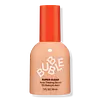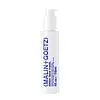What's inside
What's inside
 Key Ingredients
Key Ingredients

 Benefits
Benefits

 Concerns
Concerns

 Ingredients Side-by-side
Ingredients Side-by-side

Salicylic Acid 2%
MaskingWater
Skin ConditioningGlycerin
HumectantSqualane
EmollientOctyldodecyl Stearoyl Stearate
EmollientSodium Polyacryloyldimethyl Taurate
Emulsion StabilisingSodium Polyacrylate
AbsorbentCetearyl Alcohol
EmollientCentella Asiatica Leaf Extract
Skin ConditioningColloidal Oatmeal
AbsorbentSalvia Officinalis Leaf Extract
CleansingZinc PCA
HumectantDipotassium Glycyrrhizate
HumectantMelia Azadirachta Seed Oil
EmollientSpiraea Ulmaria Flower Extract
Skin ConditioningSalix Nigra Bark Extract
Skin ProtectingXanthan Gum
EmulsifyingCoco-Glucoside
CleansingTocopheryl Acetate
AntioxidantPotassium Hydroxide
BufferingCitric Acid
BufferingPhenoxyethanol
PreservativeSalicylic Acid 2%, Water, Glycerin, Squalane, Octyldodecyl Stearoyl Stearate, Sodium Polyacryloyldimethyl Taurate, Sodium Polyacrylate, Cetearyl Alcohol, Centella Asiatica Leaf Extract, Colloidal Oatmeal, Salvia Officinalis Leaf Extract, Zinc PCA, Dipotassium Glycyrrhizate, Melia Azadirachta Seed Oil, Spiraea Ulmaria Flower Extract, Salix Nigra Bark Extract, Xanthan Gum, Coco-Glucoside, Tocopheryl Acetate, Potassium Hydroxide, Citric Acid, Phenoxyethanol
Water
Skin ConditioningCocamidopropyl Betaine
CleansingGlycerin
HumectantMethyl Perfluoroisobutyl Ether
SolventMethyl Perfluorobutyl Ether
SolventStearic Acid
CleansingGlycine Soja Oil
EmollientCarrageenan
Palmitic Acid
EmollientCetyl Alcohol
EmollientSodium PCA
HumectantPanthenol
Skin ConditioningSodium Coco-Sulfate
CleansingButylene Glycol
HumectantSqualane
EmollientDimethicone
EmollientCocamidopropyl Hydroxysultaine
CleansingCoco-Glucoside
CleansingCamellia Sinensis Leaf Extract
AntimicrobialCaprylyl Glycol
Emollient1,2-Hexanediol
Skin ConditioningPolyhydroxystearic Acid
EmulsifyingSodium Hydroxide
BufferingAllantoin
Skin ConditioningLecithin
EmollientIsononyl Isononanoate
EmollientEthylhexyl Isononanoate
EmollientHydrolyzed Soy Protein
HumectantXanthan Gum
EmulsifyingSodium Cocamidopropyl Pg-Dimonium Chloride Phosphate
CleansingTocopheryl Acetate
AntioxidantPrunus Amygdalus Dulcis Oil
Skin ConditioningPEG-90m
Emulsion StabilisingArginine
MaskingPerfluorohexane
SolventPotassium Hydroxide
BufferingO-Cymen-5-Ol
AntimicrobialAloe Barbadensis Leaf Juice
Skin ConditioningBenzaldehyde
MaskingTetrahexyldecyl Ascorbate
AntioxidantTropolone
Skin ConditioningTocopherol
AntioxidantWater, Cocamidopropyl Betaine, Glycerin, Methyl Perfluoroisobutyl Ether, Methyl Perfluorobutyl Ether, Stearic Acid, Glycine Soja Oil, Carrageenan, Palmitic Acid, Cetyl Alcohol, Sodium PCA, Panthenol, Sodium Coco-Sulfate, Butylene Glycol, Squalane, Dimethicone, Cocamidopropyl Hydroxysultaine, Coco-Glucoside, Camellia Sinensis Leaf Extract, Caprylyl Glycol, 1,2-Hexanediol, Polyhydroxystearic Acid, Sodium Hydroxide, Allantoin, Lecithin, Isononyl Isononanoate, Ethylhexyl Isononanoate, Hydrolyzed Soy Protein, Xanthan Gum, Sodium Cocamidopropyl Pg-Dimonium Chloride Phosphate, Tocopheryl Acetate, Prunus Amygdalus Dulcis Oil, PEG-90m, Arginine, Perfluorohexane, Potassium Hydroxide, O-Cymen-5-Ol, Aloe Barbadensis Leaf Juice, Benzaldehyde, Tetrahexyldecyl Ascorbate, Tropolone, Tocopherol
 Reviews
Reviews

Ingredients Explained
These ingredients are found in both products.
Ingredients higher up in an ingredient list are typically present in a larger amount.
Coco-Glucoside is a surfactant, or a cleansing ingredient. It is made from glucose and coconut oil.
Surfactants help gather dirt, oil, and other pollutants from your skin to be rinsed away.
This ingredient is considered gentle and non-comedogenic. However, it may still be irritating for some.
Learn more about Coco-GlucosideGlycerin is already naturally found in your skin. It helps moisturize and protect your skin.
A study from 2016 found glycerin to be more effective as a humectant than AHAs and hyaluronic acid.
As a humectant, it helps the skin stay hydrated by pulling moisture to your skin. The low molecular weight of glycerin allows it to pull moisture into the deeper layers of your skin.
Hydrated skin improves your skin barrier; Your skin barrier helps protect against irritants and bacteria.
Glycerin has also been found to have antimicrobial and antiviral properties. Due to these properties, glycerin is often used in wound and burn treatments.
In cosmetics, glycerin is usually derived from plants such as soybean or palm. However, it can also be sourced from animals, such as tallow or animal fat.
This ingredient is organic, colorless, odorless, and non-toxic.
Glycerin is the name for this ingredient in American English. British English uses Glycerol/Glycerine.
Learn more about GlycerinPotassium hydroxide is commonly known as caustic potash. It is used to fix the pH of a product or as a cleaning agent in soap. In cleansers, it is used for the saponification of oils.
Sapnification is the process of creating fatty acid metal salts from triglycerides and a strong base. During this process, Potassium Hydroxide is used up and is not present in the final product.
Using high concentrations of Potassium Hydroxide have shown to irritate the skin.
Learn more about Potassium HydroxideSqualane is an emollient that helps the skin hold onto moisture. It's an oily liquid that occurs naturally in certain types of fish and plant oils.
Because squalane boosts hydration in the skin, it also comes with plenty of benefits: it is an antioxidant and can help fight free radicals and skin damage. Squalane is also found to have a detoxifying effect when applied.
Squalane comes from squalene, which occurs naturally within the sebum of our skin. It is one of the oils our skin produces to keep itself hydrated. Squalane is the hydrogenated version of squalene and has a longer shelf life.
Research shows that squalane is non-irritating (even at 100% concentration).
In general, it's a fantastic ingredient. It does a great job at hydrating the skin, and it's suitable for those with sensitive skin.
The source of squalane may impact malassezia / fungal acne. This is because olive oil derived squalane can contain impurities such as fatty acids and plant waxes. Sugarcane derived squalane is recommended for anyone with malassezia concerns.
Is squalane vegan?
This depends on the source. Squalane can be derived from both plants and animals. Most squalane used in skincare comes from plants.
Please note: the source of squalane is only known if disclosed by the brand. We recommend reaching out to the brand if you have any questions about their squalane.
Read more about squalene with an "e".
Is squalane an oil?
Squalane is often called an oil, but it’s technically not; it’s a hydrocarbon, meaning it’s only made of carbon and hydrogen, unlike true oils which are triglycerides made of fatty acids and glycerol.
The term “oil-free” isn’t regulated, so companies can define it however they want. Some exclude all oils, while others just avoid mineral oil or comedogenic oils.
While some people avoid oils thinking they cause breakouts, the right kind of oil (or oil-like ingredient like squalane) can actually help balance and hydrate your skin. It’s worth testing out simple oils or squalane to see what works best for your skin.
Learn more about SqualaneTocopheryl Acetate is AKA Vitamin E. It is an antioxidant and protects your skin from free radicals. Free radicals damage the skin by breaking down collagen.
One study found using Tocopheryl Acetate with Vitamin C decreased the number of sunburned cells.
Tocopheryl Acetate is commonly found in both skincare and dietary supplements.
Learn more about Tocopheryl AcetateWater. It's the most common cosmetic ingredient of all. You'll usually see it at the top of ingredient lists, meaning that it makes up the largest part of the product.
So why is it so popular? Water most often acts as a solvent - this means that it helps dissolve other ingredients into the formulation.
You'll also recognize water as that liquid we all need to stay alive. If you see this, drink a glass of water. Stay hydrated!
Learn more about WaterXanthan gum is used as a stabilizer and thickener within cosmetic products. It helps give products a sticky, thick feeling - preventing them from being too runny.
On the technical side of things, xanthan gum is a polysaccharide - a combination consisting of multiple sugar molecules bonded together.
Xanthan gum is a pretty common and great ingredient. It is a natural, non-toxic, non-irritating ingredient that is also commonly used in food products.
Learn more about Xanthan Gum